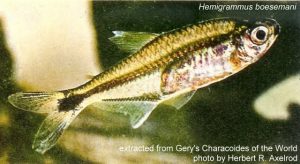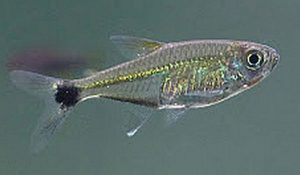Boesman’s Tetra (Hemigrammus boesemani) known to tropical fish keeping enthusiasts as the Suriname Green Line Scissors Lamp is an extremely rare species found in Suriname, French Guiana, and Peru however, because of misidentification it may exist in several other countries.
Boesman’s Tetra are a peaceful shoaling species that are found in the still, sluggish moving, tannin stained waters that exists in some of the rivers and tributaries of their range where they form up into small groups in the middle to upper layers of the water column.
The Suriname Green Line Scissors Lamp is a small, slender species that has a clear translucent body with green and bright emerald green lines on the sides and a large black splotch at the base of the caudal fin. The fish has round tail spots and faint black markings on the upper and lower edges of the caudal fin.
Males can be distinguished by the swim bladder that is visible through the translucent skin of the fish. In males the bladder tapers to a point whereas in females, it is rounded.
Adult Boesman’s Tetra grow to just under 2″ in length making them perfect candidates for a blackwater biotope setup with at least 6 or more of their own kind. They are best housed in at least a 20 gallon tank with a sandy or very fine gravel substrate, some driftwood branches, and several handfuls of dried, crushed, Indian Almond, Beech, or Oak leaves to replicate their natural waters.
A peat bag added to the filtration system can alternately be used to replicate the weak tea colored waters that they are found in. Allow the driftwood and leaves to stain the water the color of weak tea and remove the old broken down leaves from the tank every few weeks to prevent the water from fouling. As an alternate, peat bags can also be added to the aquarium filter to create blackwater conditions.
Although submerged plants can be included in this type setup, they are optional.
Because Boesman’s Tetra prefer dimly lit conditions, many tropical fish keeping enthusiasts add small floating plants like duckweed to diffuse the overhead lighting.
Boesman’s Tetras also do well in an aged densely planted tank, but because most Hemigrammus boesemani available for sale are caught in the wild, a biotope setup is much more suitable.
Lastly, Boesman’s Tetras can be housed in a community tank environment with other small, peaceful, South American species like pencil fish, Apistogramma dwarf cichlids, other Hemigrammus or Hyphessobryncon species, small Loricariids, and Corydoras.
Because Boesman’s Tetras are a shoaling species, always buy at least 6 or preferably a dozen specimens at one time. They will do much better and look their best in a small shoal when housed in this manner.
Boesman’s Tetra have been bred in an aquarium environment in a way similar to other species in the genus.
Place a group in a dimly lit 10 gallon tank with soft, acidic water with a pH of 5.5 to 6.5, a temperature between 80 and 84°F, and clumps of java moss, other fine leaved plants, or spawning mops to give the fish somewhere to deposit their eggs. Some breeders cover the base of a bare bottom tank with mesh small enough to allow the eggs to fall through and prevent the adults from getting to the eggs.
Regardless of the method, you should set up a separate rearing tank if you plan to raise a decent amount of fry. An aged corner type sponge air filter is all that is necessary for filtration. A number of successful breeders prefer RO water filtered through bags of peat to maintain optimum conditions for breeding.
Hemigrammus boesemani spawn in groups or pairs, so select half a dozen or so specimens of each sex and condition them with live baby brine shrimp, daphnia, etc. until the females are full of eggs and the males are in their best color. Select the fattest female and best looking male an place them in the breeding tank. Spawning usually occurs the following morning and the eggs will hatch 24 to 36 hours.
The fry are free swimming in 3 to 4 days and can be fed infusoria for the first few days until baby brine shrimp and microworms can be accepted. Both the eggs and fry are light sensitive and should remain in darkness for the first couple of weeks of life.
Boesman’s Tetra are omnivores and can be fed a mixed diet of live, frozen, or freeze dried flake foods, small pellets, brine shrimp, daphnia, microworms, bloodworms, etc. They are easy to feed and will eat just about any tetra fare.
Boesman’s Tetra (Hemigrammus boesemani) are extremely rare and not particularly common in their natural range. They are seldom available to tropical fish keeping enthusiasts and when seen should be scarfed up as quickly as possible regardless of price. Occasionally, online sites will have limited availabilities.
Minimum Tank Size: 20 gallons
Care Level: Moderate
Temperament: Peaceful
Aquarium Hardiness: Hardy once acclimated
Water Conditions: 74 to 79 °F , dH 2-16, pH 5.5-7.4
Max. Size: 1.8″
Color Form: Silver, Yellow, Green
Diet: Omnivore
Compatibility: Peaceful, keep with other small tetras
Origin: Suriname, French Guiana, and Peru
Family: Characidae
Lifespan: 5-10 years
Aquarist Experience Level: Advanced





